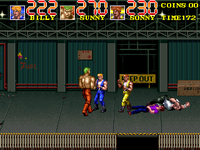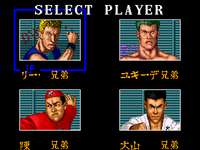- Double Dragon 3: The Rosetta Stone
-
Double Dragon 3: The Rosetta Stone 
The Japanese brochure from the arcade version, with illustration by Kazumi Kakizaki. On the background: Cleopatra and a mummy. On the foreground, from left to right: Hiruko, Billy, Jimmy, Chin, Oyama, and Urquidez.Developer(s) East Technology Publisher(s) Technos Japan Corp. Distributor(s) Bandai (European NES version)
Metro (Australian NES version)Designer(s) Yoshihisa Kishimoto Series Double Dragon Platform(s) Arcade, Amstrad CPC, Amiga, Atari ST, Commodore 64, NES, ZX Spectrum, DOS, Game Boy, Mega Drive/Genesis Release date(s) Arcade Version NES/Famicon Version - EU 1991
- NA February 1991
- JP February 22, 1991
- AUS 1994
Mode(s) Single-player, Multiplayer Double Dragon 3: The Rosetta Stone (ダブルドラゴン3 ザ・ロゼッタストーン) is a side-scrolling beat 'em up produced by Technos Japan Corp. that was originally released as a coin-operated arcade game in 1990. It is the second sequel to Double Dragon for the arcades, following Double Dragon II: The Revenge. A Nintendo Entertainment System game loosely based on the arcade version was released, along with conversions for the Sega Mega Drive/Genesis, Game Boy, and various computer platforms.
Contents
Arcade version
The premise of Double Dragon 3 is explained on the game's attract sequence: while returning to their home from a training trip, Billy and Jimmy Lee cross paths with a fortune teller named Hiruko. The fortune teller cryptically tells the brothers that they must collect the three "Rosetta Stones" scattered around the world in order to face a mysterious new adversary awaiting them in Egypt. Depending on the game's configuration, up to two or three players can play the game (similar to The Combatribes, another beat-'em-up by Technos released during the same year). As usual, the first two players take control of Billy and Jimmy in that order, while the third player assumes the role of Sonny, a yellow-clad palette swap of the Lee brothers.
The game uses a three-button control configuration like the previous titles, but discards the directional-based attack buttons from Double Dragon II, reverting back to the "Punch" and "Kick" setup of the first game. Most of the techniques from the first two titles are not featured in this installment such as the elbow punch and the hair pull, although new ones were added in their place such as a belly-to-back throw and a running head-butt. There are also techniques that can be performed with another player character such as a back-to-back hurricane kick and a triangle jump kick. The player can also jump over fallen enemies.
Certain areas in the game feature weapon shops where the player can gain additional power-ups for their character such as new moves, agility, energy, and weapons, by inserting additional credits into the game. The player can also purchase new playable characters that will replace their current character when they're killed. There are at least three additional character types in addition to the default one that the player starts the game with: the Urquidez brothers, the Chin brothers, and the Oyama brothers.
The game is divided into five stages, each taking place in a different country: America, China, Japan, Italy, and Egypt. Each stage feature their own enemy characters that fit with the setting and motif (i.e: the enemies in Japan are swordsmen in a castle, with a ninja as the boss).
Regional differences
The Japanese version of the Double Dragon 3 arcade game differs from the western release in that the player can select their character before starting the game. Players can choose between a Lee brother character or any of the other three featured character types (Urquidez, Chin, or Oyama). The weapon shops from the western release are not featured in the Japanese version, thus the two extra moves that could be purchased by the player in the western version (the hurricane kick and the one-armed headbutt) are available by default (although the hurricane kick is slightly more difficult to perform), while weapons can be found lying on the ground in certain stages (although, only the Lee brothers can use weapons).
Home versions
Nintendo Entertainment System
A Nintendo Entertainment System game loosely based on the arcade game, titled Double Dragon III: The Sacred Stones (or Double Dragon III: The Rosetta Stone in Japan) was released on February 22, 1991 in Japan and North America. As with the NES version of the second game, it was published by Technos in Japan and by Acclaim Entertainment in North America and the PAL region.
The NES version of Double Dragon III follows the same premise as the arcade version. However, the game's script was completely rewritten for its English localization, with Billy and Jimmy being given a motive to help out Hiruko search for the Sacred Stones by having Marion (the heroine from previous games) disappear again. The final boss, originally a revived Cleopatra in the arcade and Famicom versions, is now identified as a possessed version of Marion named Queen Noiram.
The NES version features different gameplay than its arcade counterpart. The player can now switch characters through a sub-screen. The player starts out as Billy or Jimmy Lee, but gains two additional characters after defeating them as bosses thorough the course of the game: Chin Seimei (a Chinese martial artist) and Yagyu Ranzou (a Japanese ninja). Each character has a secondary weapon that can be used for a limited time after equipping it from the sub-menu. In addition, the player can also use weapons from enemies like previous Double Dragon games. Each character has only one life and the game ends when all of them die (a single continue is available for the last two missions).
The NES version of Double Dragon III is notable for its typo of Billy's name as "Bimmy" in the opening intro of the 2 Players Mode. Also, the "America" setting in the first mission of the arcade version was corrected to the more accurate "U.S.A." setting.
Other platforms
In addition to the NES game, Acclaim also released two home versions of Double Dragon 3 in North American and Europe that were direct conversions of the arcade game. The Game Boy version (developed by Sales Curve) was released on August 1992, while the Mega Drive/Genesis port (developed by Software Creations) was released on December 1992.[1]
Computer ports of the Double Dragon 3 arcade game were also released in 1991 for the ZX Spectrum, Amstrad CPC, Commodore 64, Amiga, Atari ST, and IBM PC, which were all developed by The Sales Curve and published on their Storm label.
A handheld electronic game was produced by Tiger Electronics in 1988.
Soundtrack
An album containing the original soundtrack for the arcade versions of this game and The Combatribes was released by Pony Canyon in Japan, titled Double Dragon 3/The Combatribes. It was released on June 21, 1991 and its catalog number is PCCB-00065. Tracks 1 to 12 are taken from Double Dragon 3.
- "The Rosetta Stone" (arranged version)
- "The Rosetta Stone"
- "To the Dragon World"/"In America"/"The New Black Warriors"
- "Jim's Theme"/"The Way of Sōsetsuken"
- "To the Dragon World"/"In China"/"Li's Theme"
- "To the Dragon World"/"In Japan"/"Ranzou's Theme"
- "To the Dragon World"/"In Italy"/"Giuliano's Theme"
- "To the Dragon World"/"The Enchanted Forest"/"Enter the Dragon"
- "The Fearsome Goblin"/"Roppe, the Stone Man"/"Hiruko's Trap"
- "Awakening of the 2,000 Years Old Demon"/"Cleopatra's Theme"
- "To the Children of the World"
- "Play Version"
- "The Final Battle" (arranged version)
- "Title Roll"/"The Motorcycle Nuclear Warheads"/"2X4 Fatman"/"Go to next Act"
- "Amusement Park Nightmare"/"Persian Warlord"
- "The Slash Skate Screamers"/"Destroy Overdrive"
- "Place of S.O.D."/"War Paint"
- "The Slaughter Troops"/"Swastika is Cyborg"
- "The Final Battle (Martha Splatterhead)"
- "Ending (Out of Somewhere)"/"Staff Roll (Rest in Peace)"
- "Play Version"
References
- ^ Double Dragon 3: The Arcade Game is a trademark of Technos Japan Corporation. © 1990 Technos Japan Corp. Licensed exclusively to Tradewest, Inc. Programmed by Software Creations, Ltd. Sublicensed to Acclaim Entertainment, Inc. Sega and Genesis are trademarks of Sega Enterprises Ltd. Flying Edge is a trademark of Acclaim Entertainment, Inc. © 1992 Acclaim Entertainment, Inc. All rights reserved. -- From the back box of the Genesis version
External links
- Double Dragon series director
- Double Dragon 3: The Rosetta Stone at World of Spectrum
- Double Dragon 3: The Rosetta Stone at MobyGames
- Double Dragon 3: The Rosetta Stone at the Killer List of Videogames
Related games Adaptions Categories:- 1990 video games
- Amiga games
- Amstrad CPC games
- Arcade games
- Atari ST games
- Beat 'em ups
- Cooperative video games
- Commodore 64 games
- DOS games
- Double Dragon
- Game Boy games
- Nintendo Entertainment System games
- Sega Mega Drive games
- Technōs Japan games
- Tiger handheld games
- Video game sequels
- ZX Spectrum games
Wikimedia Foundation. 2010.



